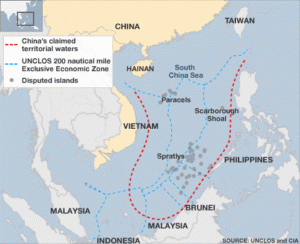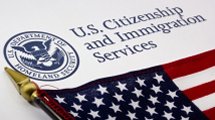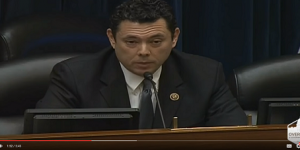UPDATE: China “Warned and Tracked” US Destroyer in South China Sea
Chinese military assets tracked and warned a US naval vessel sailing in the disputed waters of the South China Sea yesterday.
“Cui Tiankai, the Chinese ambassador to the United States, told CNN’s Christiane Amanpour in an exclusive interview that the U.S. operation is “a very serious provocation, politically and militarily” and the country’s foreign ministry summoned Max Baucus, the U.S. ambassador to China, to express its “strong discontent” over the patrol.”
China has been aggressively building up its military presence in the resource-rich South China Sea. It has been building up nearly-submerged reefs and using them as staging bases for their navy. Now, they are trying to claim a 12 mile sovereignty zone around the reefs and perhaps a 200 mile exclusive economic zone.
“A U.S. defense official told CNN that the destroyer USS Lassen “conducted a transit” within 12 nautical miles of five reefs claimed by Beijing, including Subi Reef, in the Spratly Islands on Tuesday morning.
The operation put the ship within an area that would be considered Chinese sovereign territory if the United States recognized the man-made islands as being Chinese territory, the official said.
The United States hadn’t breached the 12-mile limit since China began massive dredging operations to turn the reefs into artificial islands in 2014 — even though maritime law doesn’t usually accord territorial waters to islands built on previously submerged reefs.
U.S. Defense Secretary Ash Carter, testifying before a Senate panel, said the missions would continue.
“We will fly, sail and operate wherever international law permits and whenever our operational needs require,” he said.”
A belligerent China blustered at the American transit and issued veiled military threats against the right of navigation.
“If any country thinks that, through some gimmicks, they will be able to interfere with or even prevent China from engaging in reasonable, legitimate and legal activities in its own territories, I want to suggest those countries give up such fantasy,” ministry spokesman Lu Kang said.
“In fact, if relevant parties insist on creating tensions in the region and making trouble out of nothing, it may force China to draw the conclusion that we need to strengthen and hasten the buildup of our relevant capabilities. I advise the U.S. not to create such a self-fulfilling prophecy.”
The United States is challenging China’s efforts to restrict navigation though the critical South china Sea area.
“Greg Poling, director of the Asia Maritime Transparency Initiative at the Center for Strategic and International Studies in Washington, said that the U.S. operation was aimed at testing control of the seas, not sovereignty over the disputed islands, and would present a dilemma for China.
“It forces a clarification of China’s claims. China’s strategy in the South China Sea is one of ambiguity,” he said.
Poling said under maritime law, artificial islands were not usually afforded the 12-mile territorial zone, and that the U.S. Navy deliberately chose to send the destroyer near Subi Reef for this reason.
Before China’s recent land reclamation, both Subi and Mischief reefs were submerged at high tide, while a sandbar was visible at high tide at Fiery Cross Reef, which could make its legal status more ambiguous.
“So if Beijing objects by saying to the U.S. you’re in our territorial sea, then the U.S. can respond by saying there’s no such thing as a territorial sea for an artificial island,” Poling said.
He said the decision to go ahead with the mission follows months of discussion in Washington and likely followed Chinese President Xi Jinping’s trip there last month, which made little headway on the issue of the South China Sea.”
Oct 28: In the next 24 hours a US Navy destroyer is set to pass within 12 miles of the much disputed territorial area that China claims around artificial islands it has controversially built in the South China Sea.
Today, Chinese Foreign Minister Wang Yi responded by warning in no uncertain terms that the U.S. not “make trouble out of nothing” in the South China Sea.
“We are checking out the matter,” Wang remarked
“If it is true, we advise the U.S. to think twice before it acts,” he said, urging the U.S. to “Not act in an imprudent way and not make trouble out of nothing.”
A U.S. defense official said that the USS Lassen was approaching Subi and Mischief reefs in the Spratly archipelago, and would be in the area for several hours. The ship is likely to be accompanied by reconnaissance planes that have been conducting surveillance work in the region recently.
The mission, which has been approved by U.S. President Barack Obama, represents the most serious U.S. challenge yet to the 12-nautical-mile territorial limit China claims around the islands. The move is sure to be seen as an open challenge to China, with Beijing warning only last month that it would “never allow any country” to violate its territorial waters and airspace in the Spratlys.
China claims most of the South and East China seas. Other countries in South East Asia have competing claims for the Spratly Islands, Paracel Islands and Scarborough Shoal, which are thought to have resource-rich waters around them.
The US Freedom of Navigation programme challenges what it deems to be “excessive claims” to the world’s oceans and airspace. (BBC)
 It was developed to promote international adherence to the UN Convention on the Law of the Sea, even though the US has not formally ratified the treaty.
It was developed to promote international adherence to the UN Convention on the Law of the Sea, even though the US has not formally ratified the treaty.
In 2013 and 2014, the US conducted Freedom of Navigation operations of different kinds against China, Malaysia, the Philippines, Taiwan, and Vietnam – each of whom occupies territory in the South China Sea




























